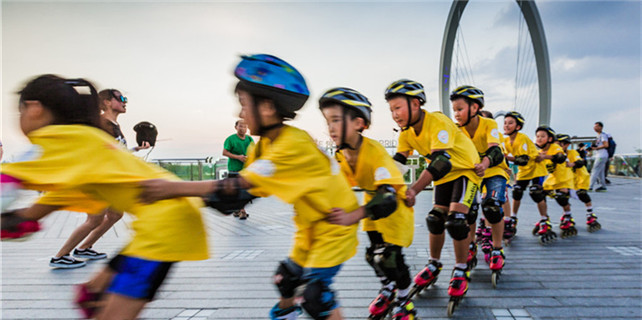Learning To Love Life Again, One Step At A Time
Running has given a group of amputees a renewed sense of purpose, as Dara Wang reports from Hong Kong.
Irene Yu Kuk-ying, 59, has become an inspiration to many people as a result of her determination to overcome an accident that changed her life forever.
Yu lost her right leg when she was 18 and just starting at college. Today, she can run again. It may be just 200 meters a day, but that's OK as long as she completes her task.
Every day, she shares her photos on social media, earning herself 2,400 fans on Facebook. Her followers praise her as outgoing, resilient and cheerful.
Yu started running again in February, decades after the incident that claimed her leg one Valentine's Day, when she was scheduled to register at Guangxi University in Nanning, the capital of the Guangxi Zhuang autonomous region in South China.
However, admissions had been postponed until the next day, so she strolled around the campus, thinking about the future and wondering what college life would be like.
Water tower collapse
The campus had a water tower. Yu saw a group of students standing near it, washing their hands. As Yu walked past the tower, it crashed to the ground. Instinctively, she pushed aside a young man ahead of her, but she was buried by the rubble.
Yu awoke in a clinic. She couldn't feel anything, but she remembered a persistent dream in which two friends she couldn't see were calling out to her. At the time, she didn't know that her friends, who had also been at the scene, had died in the collapse and their bodies were lying beneath the shattered masonry.
When she regained consciousness, she saw blood gushing from her leg. "I didn't cry. I reassured my family and told them not to be afraid, and then I lost consciousness again," she recalled.
Peonies were Yu's favorite flowers. For her, their lavish, blood-red petals were symbols of life. When the time came for the surgery to amputate her shattered leg, a friend brought her a peony. Yu's mother remembered how her daughter gripped the stalk until the juice ran down her arm, but she hung on and didn't shed a single tear.
It was nearly two months before Yu could make any sense of the world again. The first thing she remembered was peonies, everywhere, in every part of her room.
Then, she suddenly realized that her right leg was missing. "If the window had not been beyond my reach, I would have committed suicide," she said.
The amputation greatly limited Yu's mobility, but worse still, it took away her self-confidence. She was fitted with an artificial leg, which seemed pretty close to the real thing, but wasn't the same.
Shattered dreams
Once she started living again, Yu began a career in sales. Although she excelled at the job, her dreams were all gone. The memory of what had happened to her and her friends hung over her like a dark cloud wherever she went.
"I'm not willing to go in disguise, as an amputee. I just can't do that," she said.
The cloud hung over her for decades. Then, earlier this year, she summoned the courage to attend a three-day event called the Running Clinic. It wasn't until the last day that she ran, for the first time in more than 40 years. She called it "one of the most meaningful days of my life".
A panacea
Sixteen amputees participated in the Running Clinic, which was organized by the Ottobock Group, a German prosthetics company. They were taught to walk and run as if they had no impairment at all.
The trainer was Heinrich Popow, a Paralympean who won a sprinting gold medal for Germany. He understood that a lack of self-confidence is the biggest stumbling block for amputees learning to walk and run normally once again.
"They just don't believe they can do it like other people," he said, adding that he believes running is a panacea for them.
"If you can finish a sprint, there is no difficulty going shopping with your wife and kids. Sports are something above daily life. It is especially critical for amputees to regain their confidence."
Popow asked the trainees to set a goal and run every day. However, they are not allowed to raise questions or doubts that could destroy their initiative.
With little hesitation, Yu set her goal at 500 meters. She started in the playground with Popow. "I almost cried when my legs started to run. Feelings that had been lost for so many years came back and became unforgettable," she said.
She found peers and even role models at the Running Clinic, including Camel Fung Kam-hung, a 65-year-old who was the first person in Hong Kong to be fitted with a running blade when the device was introduced in the city 10 years ago.
Fung taught physical education at a primary school, but his career ended when he lost his left leg in a traffic accident 38 years ago.
"As a person in a sports-related occupation, I probably experienced more frustration than most after the amputation," he said. "I had to give up my career and become a clerk. I felt I was being wasted."
It took more than two decades before he found the blade. "The light, elastic blade makes running easier. I started taking up sporting activities," he said.
Distance running became Fung's solace and compensation. His legs no longer felt useless. Better still, he learned he could measure up to able-bodied people, and sometimes even do better.
When he retired from his office job, Fung joined a 100-kilometer hike. Later, he completed a half-marathon. Then he signed up for a grueling competition; a seven-day, 250-km trek across the Atacama Desert in Chile, teaming up with his wife and a friend.
Fung was the first amputee to finish the Atacama Crossing. He and his two companions also won the team competition. People talked about how Fung showed terrific resilience in the face of many trials during the long walk.
The team hadn't gone far before Fung discovered a crack between his prosthesis and the sole of his hiking boot. He had walked about 40 km, but there was still a long way to go.
"I had to go all the way to overcome my limitations. Though my performance wasn't as good as I'd hoped, after that, I had to continue," he said, recalling how he trekked over peaks and through valleys for more than 200 kilometers with his prosthesis held together with glue and tape.
As an experienced racer, Fung said determination is a big factor, but there is much more. To compete hard, racers need systematic training, learning to stretch themselves to the edge of their limits, but pace themselves to stay within the limits.
"The more I train, the more I trust my prosthetic leg. Amputees are like other people in sports - they need training and sportsmanship," he said.
Running gave Fung a new life. He, his wife and their friends called their team "Five Legs Never Quit". Not only did they stay the course, they returned to China and completed a long march across the Gobi Desert in Northwest China last month. They also plan to compete in next year's Desert Crossing in Chile.
Fung said that once he got back into running, he couldn't stop. Yu has continued to run every day since the workshop.
Yu conceded that running can be painful. "Amputees suffer from friction between the stump and the prosthetic limb," she said, adding that she endures the discomfort and continues to exercise.
"As long as I can run, I will keep running. It is a way for me to train my body and mindset and live in a respectful way. It's become an essential part of my life."
Contact the writer at dara@chinadailyhk.com
(China Daily 08/31/2017 page6)






















